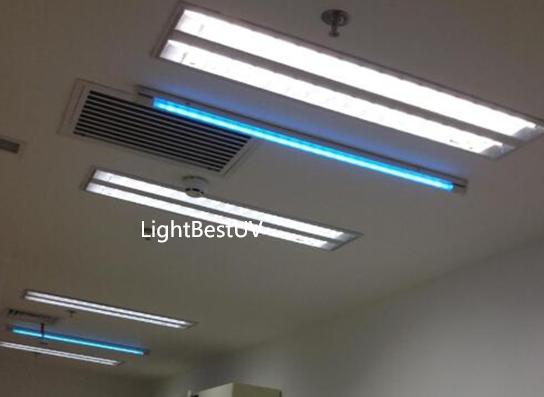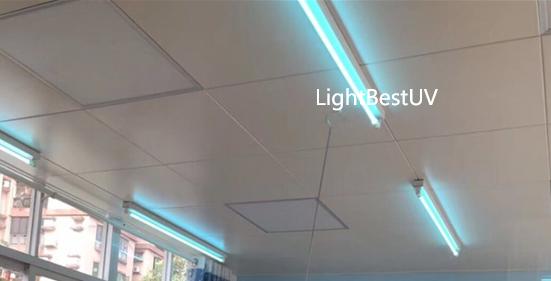The disinfection effectiveness of ultraviolet (UV) lamps is closely related to distance and exposure time. The core principle is that the UV dose (irradiance × time) must reach a threshold sufficient to inactivate microorganisms, and distance directly affects the attenuation of irradiance.
I. The Impact of Distance on Disinfection Effectiveness
1.Inverse Square Law
Ultraviolet (UV) intensity decreases exponentially with increasing distance. Specifically, when the distance is doubled, the intensity drops to one-quarter of its original value. For example:
lIf the UV intensity is 100 μW/cm² at 1 meter, it drops to only 25 μW/cm² at 2 meters.
lIf a microorganism requires a dose of 30 mJ/cm² to be inactivated, it would take 5 minutes at 1 meter (100 μW/cm² × 300 seconds = 30 mJ/cm²), but 20 minutes at 2 meters (25 μW/cm² × 1200 seconds = 30 mJ/cm²).
2.Effective Disinfection Range
lAir Disinfection: According to the Hospital Disinfection Technical Specifications, a 30W UV lamp has an effective disinfection range of 1.5 to 2 meters, during which the radiation intensity is ≥70 μW/cm²—the threshold for germicidal effectiveness. Beyond 2 meters, the intensity drops sharply, making disinfection unreliable.
lSurface Disinfection: It is recommended to keep a distance of 30–60 cm between the UV lamp and the surface being disinfected to ensure sufficient dosage per unit area. For example, porous materials (like fabric) may require over 40 minutes of exposure, while smooth metal surfaces may only need 15 minutes.
3.Risks of Being Too Close
If the distance is too short (e.g., less than 10 cm), it may cause the lamp to overheat and shorten its lifespan, or lead to localized overexposure (such as scorching the surface of objects) due to concentrated UV rays.

ⅡThe Impact of Exposure Time on Disinfection Effectiveness
1. Relationship Between Dose and Time
The germicidal effectiveness of ultraviolet (UV) light is directly proportional to the irradiation dose (Dose = Intensity × Time). When the radiation intensity remains constant, a longer exposure time results in a higher dose and stronger sterilization effect. For example:
lA 30W UV lamp needs 30 minutes to disinfect a 1 cubic meter space, whereas a 15W lamp requires 60 minutes for the same effect.
lIn humid environments (humidity > 70%), water molecules absorb UV energy, reducing effectiveness. In such cases, extend exposure time to over 40 minutes or use a dehumidifier to lower humidity below 50%.
2. Recommended Exposure Times for Different Scenarios
lSmall enclosed spaces (e.g., 10㎡ room): 30 minutes is sufficient to cover all corners and eliminate common bacteria.
lLarge spaces (e.g., 50㎡ room): More than 60 minutes is needed to ensure that distant areas receive an adequate UV dose.
lHighly contaminated environments (e.g., hospital wards): For resilient pathogens like spores and viruses, close to 60 minutes of exposure is recommended.
3. Drawbacks of Excessive Exposure Time
Prolonged exposure beyond 1 hour may result in:
lOverheating of the UV lamp, leading to faster aging and reduced service life.
lExcessive ozone production (especially with low-power lamps), which requires at least 30 minutes of ventilation after disinfection.

III. Synergistic Effect of Distance and Time
1. Dynamic Adjustment Strategies
If spatial limitations prevent reducing the distance, the exposure time must be extended. For example:
lAn increase of 10 cm in distance requires approximately 5 additional minutes of exposure.
lFor complex instruments, all components should be unfolded; fabrics should be laid out in a single layer to avoid disinfection blind spots.
In open spaces, continuous exposure of more than 2 hours is recommended. In enclosed environments, 30 minutes may suffice due to unblocked UV diffusion.
2. Operational Guidelines
lAir Disinfection: Hang the UV lamp at the center of the room, less than 1.5 meters from the ceiling and 2–2.5 meters from the floor to ensure even coverage.
lSurface Disinfection: Use mobile lamp stands or multiple fixtures, maintaining a distance of 30–60 cm, and cycle through different areas to ensure full coverage.
lSafety Precautions: Close doors and windows, turn off ventilation systems, and ensure no personnel remain in the room during disinfection. Pregnant women, children, and individuals with photosensitivity should avoid operation. Use protective goggles and isolation gowns when necessary.
IV. Practical Application Cases
Hospital Ward Disinfection: Using a 30W UV lamp at a distance of 1.5 meters for 60 minutes can eliminate over 90% of airborne and surface microbes, including drug-resistant bacteria.
Home Clothing Disinfection: Lay clothes in a single layer at a distance of 50 cm from the UV lamp, exposing for 40 minutes to effectively remove mold and odors.
Laboratory Equipment Disinfection: Unfold all components, expose at a distance of 30 cm for 15 minutes, and wipe with 75% alcohol to achieve a 99.9% sterilization rate.
Post time:2025-07-03 15:02:45

